Vitamins Market Research, 2031
The global vitamins market size was valued at $28.8 billion in 2021 and is projected to reach $59.2 billion by 2031, growing at a CAGR of 7.5% from 2021 to 2031.
The global vitamin industry is impacted profoundly by the outbreak of the coronavirus. The outbreak was first witnessed in China resulting in a lockdown and the ceasing of production activities across the country. The demand for vitamins is expected to slightly taper across the world, owing to supply chain disruptions and the implementation of stringent restrictions to follow social distancing & consistent lockdowns across the globe
Vitamins are essential nutrients in the human body to maintain health & wellness. Vitamins play an important role in digestion, health, immunity boosting, mental health, and overall smooth performance of the body. The compromised quality of agricultural produce and food products is impacting human health negatively and not able to fulfill the nutritional requirement of the body. It is difficult to consume the required number of vitamins & nutrients from regular food intake. Thus, vitamin supplements are consumed to reach the levels of daily nutrient intake. The demand for vitamin supplements is increasing across the globe.
The post-menopause female population is more susceptible to diseases such as anemia, osteoporosis, osteoarthritis, fibromyalgia, obesity, and depression. According to the World Health Organization (WHO), 18.0% of women above 60 years have osteoarthritis globally, out of which 80% have movement limitations and 25% cannot perform major activities of daily life. In August 2019, the Food and Drug Administration (FDA) reported that women use dietary supplements to deal with menopausal symptoms. Vitamin supplement aimed to reduce the risk of health problems associated with post-menopause such as osteoporosis is expected to increase acceptance of women’s health vitamin supplements. The change in dietary habits, lifestyle, and inadequate nutrient consumption is also responsible for causing fertility issues and other problems in women. The increase in health problems among women is expected to propel the growth of the vitamin market.
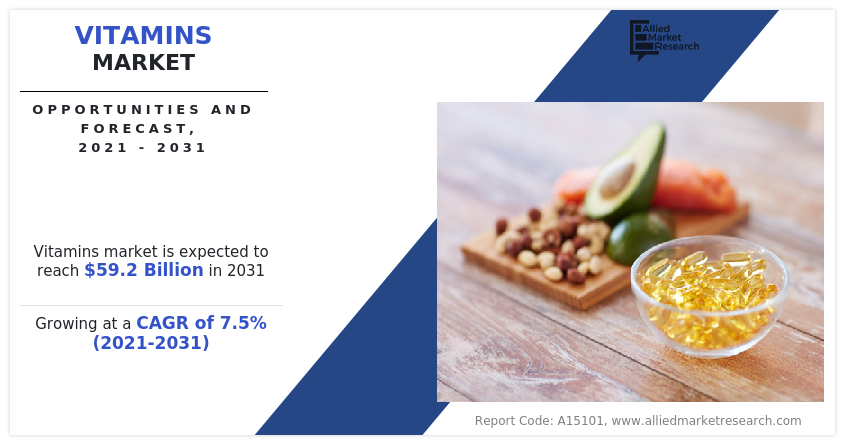
There has been observed a surge in healthcare costs, which is projected to be a crucial factor in the vitamins market growth. According to the report of the Tennessee Advisory Commission on Intergovernmental Relations, in the U.S., the overall cost of healthcare rose from 2018 to 2019 and spending increased by 4.6% to a total of $3.6 trillion. Due to such a rise in healthcare costs, people are shifting towards vitamin supplements to maintain health and immunity which help to prevent infection and diseases. Therefore, the rising consumer expenditure on vitamins supplement which prevent disease and infections is expected to drive the growth of the vitamin market.
Manufacturers are modifying their marketing and branding approaches for their goods in order to boost sales in various nations. Manufacturers have implemented cutting-edge tactics to boost sales of vitamins supplement, including the introduction of new products with natural ingredients and inventive packaging. A common tactic used by producers to draw in more consumers is the use of natural components while manufacturing vitamins that don't harm health. This aids in boosting the revenue of businesses engaged in this sector. Collectively, all these strategies adopted by manufacturers drive the vitamins industry.
The demand for plant-based ingredients in vitamin supplement products has increased owing to more people choosing cruelty-free products as a result of their increased concern for animal welfare and the environment. An increase in the number of people who are becoming a part of corporate culture and giving importance to diet and nutritional requirements of the body to maintain health and prevent health problems fuels the growth of the vitamin market. The market is anticipated to be driven by the increase in spending on health supplements by consumers. Growing health consciousness and an increase in disposable income are anticipated to have a positive impact on market growth. An increase in awareness through advertisements, social media blogs, YouTube channels, and influencers is likely to augment the vitamins market demand.
The market in Asia-Pacific offers lucrative growth opportunities for operating players, owing to the presence of countries such as India, China, Australia, and New Zealand. The increase in the adoption of health supplements and the rise in health consciousness among consumers in developing countries such as China, India, and others majorly drive the growth of the vitamins market. Moreover, an increase in awareness regarding skin care products and their associated benefits has further led to the growth of the market. Developing regions offer potential growth opportunities to market players for launching innovative skin care products. Moreover, countries in Latin America, such as Brazil, are anticipated to unfold attractive business opportunities, owing to an increase in awareness regarding vitamin supplement and their benefits.
Furthermore, a significant rise in the penetration of online pharmacies is significantly contributing to the market growth. It is easy for consumers to purchase vitamin supplements online as it provides them with a home delivery facility, and they can get information about the product while sitting at home. There is a huge rise in the number of online pharmacies globally, in the past few years, owing to the rise in penetration of the internet and digital devices. Online pharmacies such as Apollo, Netmeds, and Pharm Easy provide various offers and discounts to consumers to lure them. A surge in the number of online pharmacies is expected to create an opportunity for the vitamins market to grow significantly.
As synthetic vitamin supplements directly impact the wellness of consumers, the safety of ingredients & supplement products must be ensured. Government organizations such as the FDA (Food and Drug Administration) are prohibiting adulterated & unsafe dietary supplements from reaching the target market and endangering consumer health. However, companies producing health supplements must meet the terms of the Dietary Supplement Health and Education Act (DSHEA) guidelines and rules set by the Food and Drug Administration. Furthermore, companies manufacturing dietary supplements must review & analyze their products to ensure they are not adulterated and are properly labeled, thus safe for consumption. If a health supplement contains a new ingredient, companies are compelled to inform the FDA before commercializing their product. Thus, the stringent regulations on the production of vitamins are expected to hinder the growth of the vitamin market.
According to the market analysis, the global vitamin market is segmented into the source, type, application, and region. By source, the market is divided into the plant, animal, and synthetic. Based on type, the market is divided into Vitamin A, Vitamin B, Vitamin C, Vitamin D, Vitamin E, and Vitamin K. By application, the market is divided into digestive health, immunity, mental health, cosmetics, performance, digestive disorders, menstrual health, pregnancy, sports & performance, and others. Region-wise, the market is analyzed across North America (the U.S., Canada, and Mexico), Europe (Germany, France, UK, Spain, Italy, rest of Europe), Asia-Pacific (China, Japan, India, Australia, South Korea, South East Asia and rest of Asia-Pacific), and LAMEA (Latin America, Middle East, and Africa).
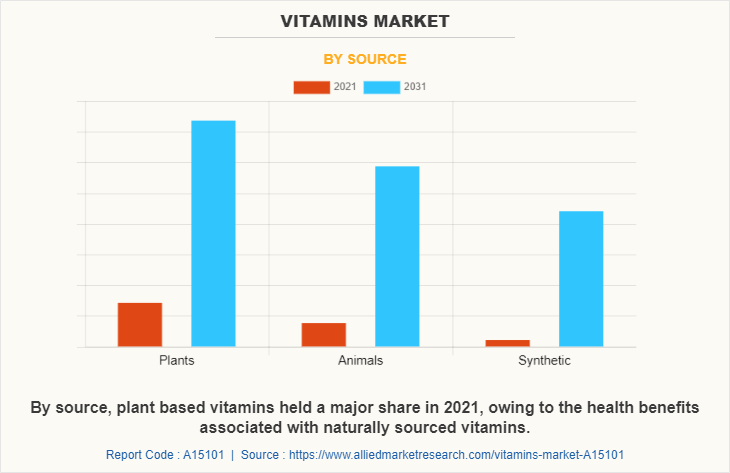
The plant-based vitamins accounted for more than 30% of the market share, in terms of revenue, in 2021 as it is being widely consumed & popular among consumers. Vitamins are traditionally sourced from animal products, and plant-based vitamins are a growing trend in developed countries. Consumer interest in plant-based products & vegan lifestyles has skyrocketed over the past few years, and manufacturers are noticing this trend. This segment is projected to dominate the market during the vitamins market forecast period and is anticipated to show significant growth in Asia-Pacific, whereas growth will remain steady in North America.
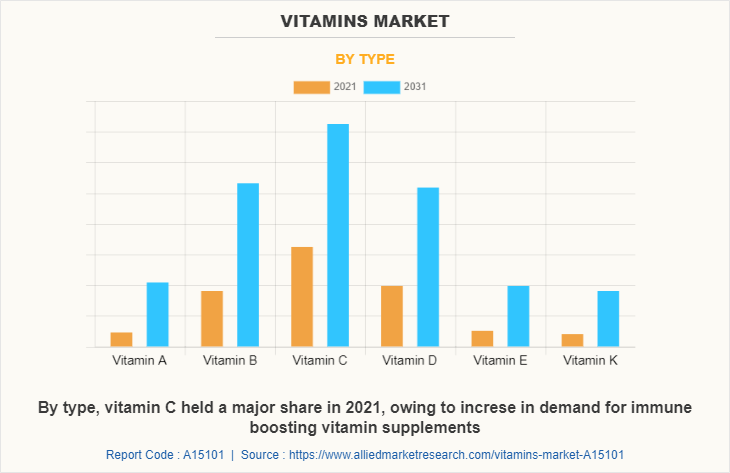
As per type, vitamin B is estimated to witness the highest CAGR of 8.6% during the forecast period. The B group vitamins such as B1, B2, B3, B5, B6, and B12 are essential for health & brain development. The rise in demand for vitamin B supplements in Europe and North America plays a crucial role in the growth of the vitamin B segment. According to the Indian Journal of Medical Research (IJMR), around 33% of the population in the U.S. and several major nations of Europe such as Denmark, the UK, and Sweden regularly consume dietary supplements that boost the growth of vitamin B segment. Vitamin B complex is very useful in the treatment of non-nutritional disorders such as hyperlipidemia and Wernicke–Korsakoff syndrome. Vitamin B supplements are recommended by physicians to people above 50 years of age and women of childbearing age.
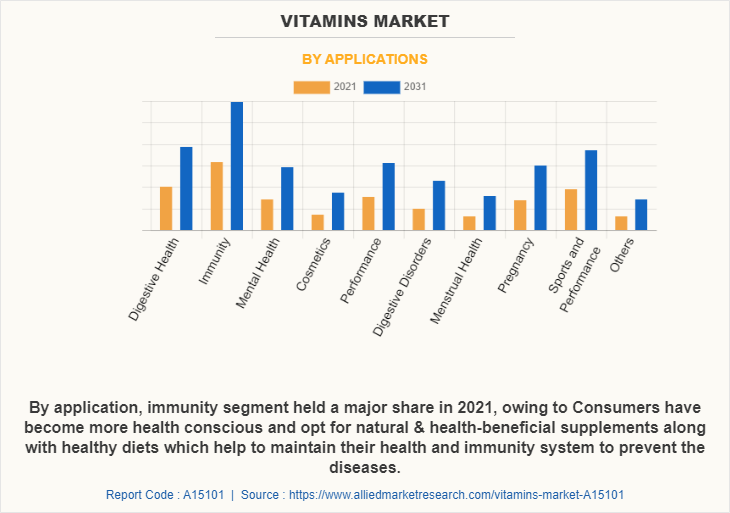
By application, the global vitamins market is categorized into digestive health, immunity, mental health, cosmetics, performance, digestive disorders, menstrual health, pregnancy, sports & performance, and others. The immunity segment led the market and accounted for 22.0% of the vitamins market share in 2021 and is expected to maintain its dominance during the forecast period. After the pandemic situation, demand for immunity-boosting supplements has increased owing to their health benefits & immunity-boosting properties. Consumers have become more health conscious and opt for natural & health-beneficial supplements along with healthy diets which help to maintain their health. These ongoing trends are expected to create more opportunities for manufacturers to develop natural vitamin supplements to cater the consumer demand. Rise in awareness about vitamin supplements to boost immunity is expected to benefit the growth of the segment in the upcoming years.
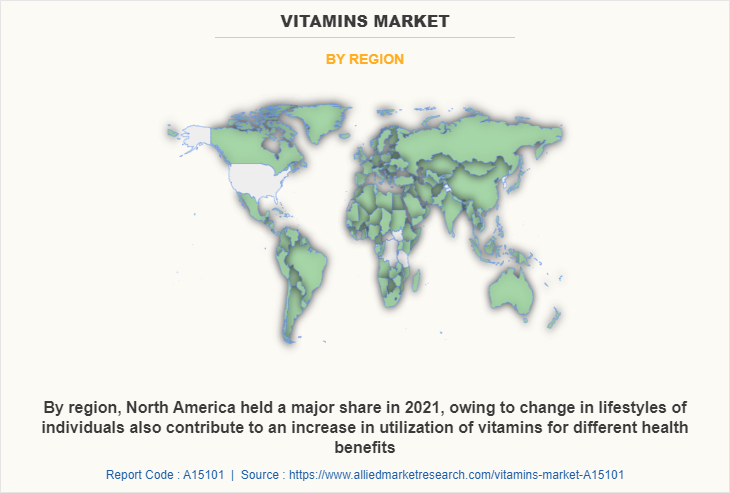
Region-wise, North America was the largest market in 2021 and had the highest market share of 38.6%. North America is the major market for vitamin supplements. Due to an increase in unhealthy diet patterns, a rise in disposable income, and access to a variety of processed & ready-to-eat foods, North Americans are becoming more obese and developing lifestyle-related ailments. In light of this, consuming fortified, enhanced, enriched, and improved foods, as well as nutritious supplements on a regular basis as part of a diversified diet, may benefit health. As a result of this, multivitamins have become a key component of the North America vitamins market. According to the National Institutes of Health, the U.S. sales of all dietary supplements totaled an estimated $55.7 billion in 2020, including $21.2 billion for all supplements containing vitamins, minerals, or both, of which $8.0 billion was for multivitamin/mineral and multivitamins.
The players in the vitamin market have adopted acquisition, business expansion, partnership, collaboration, and product launch as their key development strategies to increase profitability and improve their position in the vitamins market. Some of the key players profiled in the vitamins market analysis include Adisseo, Archer Daniels Midland Company, BASF SE, BROTHER ENTERPRISES HOLDING CO., LTD, Farbest Brands, Glanbia PLC, Jubilant Bhartia Group, Koninklijke DSM N.V., Lonza, Stern Wywiol Gruppe, Vertellus, Vitablend Nederland B.V., Wright Enrichment Inc, Zagro, and Zhejiang Garden Bio-chemical High-tech Co., Ltd
Key Benefits For Stakeholders
- This report provides a quantitative analysis of the market segments, current trends, estimations, and dynamics of the vitamins market analysis from 2021 to 2031 to identify the prevailing vitamins market opportunities.
- The market research is offered along with information related to key drivers, restraints, and opportunities.
- Porter's five forces analysis highlights the potency of buyers and suppliers to enable stakeholders make profit-oriented business decisions and strengthen their supplier-buyer network.
- In-depth analysis of the vitamins market segmentation assists to determine the prevailing market opportunities.
- Major countries in each region are mapped according to their revenue contribution to the global market.
- Market player positioning facilitates benchmarking and provides a clear understanding of the present position of the market players.
- The report includes the analysis of the regional as well as global vitamins market trends, key players, market segments, application areas, and market growth strategies.
Vitamins Market Report Highlights
| Aspects | Details |
| Market Size By 2031 | USD 59.2 billion |
| Growth Rate | CAGR of 7.5% |
| Forecast period | 2021 - 2031 |
| Report Pages | 320 |
| By Source |
|
| By Type |
|
| By Applications |
|
| By Region |
|
| Key Market Players | BASF SE, Jubilant Bhartia Group, Adisseo, Vitablend Nederland B.V., Farbest Brands, Wright Enrichment Inc, Koninklijke DSM N.V., Stern Wywiol Gruppe, Archer Daniels Midland Company, BROTHER ENTERPRISES HOLDING CO.,LTD, Glanbia PLC, Vertellus, Zagro, Lonza, Zhejiang Garden Bio-chemical High-tech Co., Ltd |
Analyst Review
According to the insights of CXOs of leading companies, the vitamins market holds a substantial scope for growth; however, its contribution to the world market would increase significantly within the next six years. Innovation is the key to the success of the vitamins market. With the increase in demand for vitamins from the nutraceutical and cosmetics industry, manufacturers are investing more in R&D to cater to the increasing demand for vitamins by the end industries. Manufacturers are increasingly incorporating the latest technology to increase production efficiency and quality. The rise in demand for naturally sourced vitamins among consumers makes way for manufacturers to come up with natural vitamins and supplements products along with affordable prices and eco-friendly packaging.
The global vitamins market size was valued at $28,783.5 million in 2021 and is projected to reach $59,238.5 million by 2031, registering a CAGR of 7.5% from 2022 to 2031.
The global vitamins market is segmented into source, type, application, and region. By source, the market is divided into the plant, animal, and synthetic. Based on type, the market is divided into Vitamin A, Vitamin B, Vitamin C, Vitamin D, Vitamin E, and Vitamin K. By application, the market is divided into digestive health, immunity, mental health, cosmetics, performance, digestive disorders, menstrual health, pregnancy, sports & performance, and others. Region-wise, the market is analyzed across North America (the U.S., Canada, and Mexico), Europe (Germany, France, UK, Spain, Italy, rest of Europe), Asia-Pacific (China, Japan, India, Australia, South Korea, South East Asia and rest of Asia-Pacific), and LAMEA (Latin America, Middle East, and Africa).
Asia-Pacific
The major players analyzed for the vitamins market are Adisseo, Archer Daniels Midland Company, BASF SE, BROTHER ENTERPRISES HOLDING CO., LTD, Farbest Brands, Glanbia PLC, Jubilant Bhartia Group, Koninklijke DSM N.V., Lonza, Stern Wywiol Gruppe, Vertellus, Vitablend Nederland B.V., Wright Enrichment Inc, Zagro, and Zhejiang Garden Bio-chemical High-tech Co., Ltd.
The global vitamins market report is available on request on the website of Allied Market Research.
The forecast period considered in the global vitamins market report is from 2022 to 2031. The report analyzes the market sizes from 2022 to 2031 along with the upcoming market trends and opportunities. The report also covers the key strategies adopted by the key players operating in the market.
The base year calculated in the vitamins Market report is 2021.
Loading Table Of Content...


